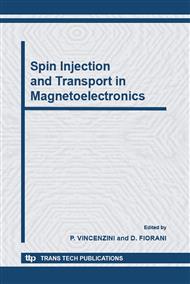p.1
p.11
p.21
p.27
p.31
p.36
p.42
p.48
Isolated and Grouped Co Spins in Polycrystalline Zn1-xCoxO Oxides
Abstract:
Polycrystalline stoichiometric Co-substituted ZnO oxides have been synthesized by solid state reaction via sintering ZnO and Co powders in air. The precise nature of magnetic coupling is determined by studying carefully structural and magnetic properties. The magnetization as a function of temperature for Zn1-xCoxO (x = 0.02, 0.05, 0.0625 and 0.10) can be fitted well to a model with a paramagnetic Curie term, an antiferromagnetic Curie-Weiss term and a diamagnetic constant, which could arise from spins of isolated Co ions, grouped Co ions that are in nearest neighbor positions and a diamagnetic background, respectively. The substitution of Co at the Zn sites does not occur in a completely random manner but the Co ions appear to have a tendency for grouping. It is interesting to note in Raman measurements that host lattice defects with 2 distinct impurity modes may be induced by isolated and grouped Co spins.
Info:
Periodical:
Pages:
27-30
Citation:
Online since:
October 2006
Authors:
Keywords:
Price:
Сopyright:
© 2006 Trans Tech Publications Ltd. All Rights Reserved
Share:
Citation:


